Comments / Questions (154)
![]() Kari wrote:
Kari wrote:
Golden Rose - ich möchte mein nächstes Bolero mit 37Lm Bogen anfangen das es vorne fast zusammen kommt. Können Sie mir bitte mitteilen met wieviel Lm muss ich anfangen
21.06.2024 - 14:59DROPS Design answered:
Liebe Kari, leider können wir jede Anleitung nicht an jeder Anfrage anpassen. Ihr DROPS Händler kann vielleicht Ihnen gerne - auch per Telefon oder pr E-Mail weiterhelfen. Danke im voraus für Ihr Verständnis. Viel Spaß beim Häkeln!
21.06.2024 - 15:57
![]() Kari Blask wrote:
Kari Blask wrote:
Hallo, ich habe dieses Goden Roses Bolero gehäkelt. Bin so happy damit. Hätte jetzt gerne das gleiche lockmuster aber das die vordere Seiten fast zusammen kommen. Hat bitte jemand so ein Muster für mich. Vielen Dank!
12.06.2024 - 14:52DROPS Design answered:
Liebe Frau Blask, hier finden Sie alle unsere Anleitungen für gehäkelte Jacken mit Lochmuster, eine davon wird Ihnen vielleicht inspirieren. Viel Spaß beim Häkeln!
12.06.2024 - 16:34
![]() Kari Blask wrote:
Kari Blask wrote:
Sehr schönes Bolero! Habe eine Frage: 3.R (den kleinen Lm-Bogen überspringen)? Warum nur hier kleinen Bogen überspringen? Es gibt doch vielen kleBögen bögen!
20.05.2024 - 17:10DROPS Design answered:
Liebe Frau Blask, man wird nur in den grösseren Luftmaschenbogen (mit 7 Luftmaschen) häkeln und nicht in den kleineren (mit nur 3 Luftmaschen). Viel Spaß beim Häkeln!
21.05.2024 - 13:48
![]() Marie wrote:
Marie wrote:
Jag tycker liksom många andra här att det blir förvirrande när axlarna ska virkas ihop. Det tog ett tag för mig att förstå vad som var uppe och nere på koftan. Dessutom blir ju ärmhålen betydligt större än de fem luftmaskbågar som jag hela arbetet trott skulle utgöra ärmhålen, eftersom axlarna virkas ihop en bra bit ovanför dessa, om jag nu fattat rätt…
14.06.2022 - 00:36
![]() Cynthia wrote:
Cynthia wrote:
I would like support on how to put the flowers together
09.10.2021 - 11:08DROPS Design answered:
Dear Cynthia, for the flower read through the description and pay attention to which rows should be crocheted from underneath the previous row. Afterwards,, you should stitch them together, in the outer loop of th efinal row. Happy Stitching!
09.10.2021 - 18:49
![]() Nicole Guay wrote:
Nicole Guay wrote:
In the American English version of the pattern, the instructions after round 5 of the flower say to "Place the centre of flower on the row of dc...". I'm confused about this because I can't find where in the pattern it told me to do a row of dc. Is it supposed to be instead that it's attached to the row of sc that was done during the assembly section?
26.09.2021 - 19:13DROPS Design answered:
Dear Nicole, you should place the flovers at the edge of the bolero, on the row of sc-s (sc is dc in British English, it is easy to mix them up). Happy Stitching!
27.09.2021 - 03:31
![]() Vandana wrote:
Vandana wrote:
How many rows to make wd front piece .. 21 cm equal to 7 large loop?nd we r making lengthwise n.. means rows shows length?
18.03.2020 - 20:57
![]() Vandana wrote:
Vandana wrote:
Hi I made till 39 large loop but after I m not getting front peace.. plz help
18.03.2020 - 04:23DROPS Design answered:
Dear Vandana, when piece measures 21 cm (in 2nd size) you will now divide piece finishing each piece separately, ie work right front piece over the firts 7 large ch-loops at the beg of the row. You will work later the left front piece over the first 7 large -ch-space on the other side of the row. And then work the back piece over the middle 19 ch-loops (there will be 3 large ch-loops between each front piece and back piece for armhole). Happy crocheting!
18.03.2020 - 08:52
![]() Susan wrote:
Susan wrote:
I was having trouble figuring out how to assemble the shoulders but after I set the pattern down for a day and looked at it again with fresh eyes, it was easy; very pretty too. Thank you Drops for such a great pattern.
12.06.2019 - 05:13
![]() Susan wrote:
Susan wrote:
I’ve come to the assembly and have a question about crocheting the shoulders together; not sure where to begin the slip stitches and how many per large loop. Do you start and the shoulder and work inward toward the neckline?
10.06.2019 - 07:02DROPS Design answered:
Dear Susan, start with a sl st in the middle of 1st ch-space on front piece, then 4 ch, 1 sc in the 1st ch-space on back piece, 4 ch, 1 sc in 2nd ch-space on front piece, and so on until you have crocheted all ch-spaces on front piece (starting from armhole towards neck). Happy crocheting!
11.06.2019 - 11:42
Golden Roses#goldenrosesbolero |
|
 |
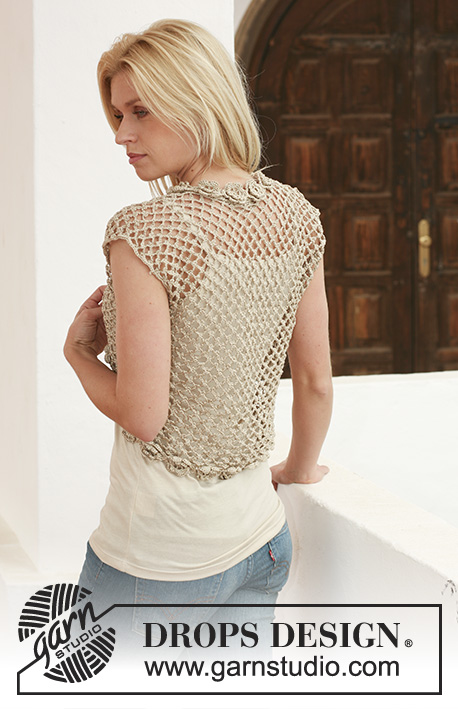 |
Crochet DROPS bolero in ”Cotton Viscose” with flower border round the opening. Size S - XXXL.
DROPS 111-25 |
|
|
BOLERO: Work 105-115-125-135-145-155 ch with crochet hook size 3 mm and Cotton Viscose. ROW 1: 1 dc in 15th ch from hook, and continue as follows: *7 ch, skip 4 ch, 1 dc in next ch *, repeat from *-* = 19-21-23-25-27-29 ch-loops on row, turn piece. ROW 2: 14 ch, 1 dc in the middle of the 7 ch in first ch-loop from previous row, 3 ch, 1 dc in the same ch, * 7 ch, 1 dc in the middle ch in next ch-loop, 3 ch, 1 dc in the same ch *, repeat from *-*, and finish with: 7 ch, 1 dc in 3rd ch in the last ch-loop, 3 ch, 1 dc in the same ch, 7 ch and 1 dc in 8th ch in the last ch-loop, turn piece. ROW 3: 14 ch, 1 dc in the middle ch in first large loop from previous row, 3 ch, 1 dc in the same ch, * 7 ch, 1 dc in the middle ch in next large ch-loop (skip the small ch-loop), 3 ch, 1 dc in the same ch *, repeat from *-*, and finish with: 7 ch, 1 dc in 3rd ch in last large ch-loop, 3 ch, 1 dc in the same ch, 7 ch and 1 dc in 8th ch in last large ch-loop, turn piece. Repeat row 3, i.e. inc 1 loop on every row, until there are 35-39-43-47-51-55 large ch-loops on row, finish the last row as follows: 1 dc + 3 ch + 1 dc in 4th ch in last ch-loop, turn piece. The inc are now complete. Continue as follows: Beg each row with 7 ch instead of 14, then 1 dc + 3 ch + 1 dc in the middle st in the first large ch-loop from previous row, continue across the row as before and finish with 1 dc + 3 ch + 1 dc in 4th ch in last ch-loop, turn piece. AT THE SAME TIME when piece measures 20-21-23-25-27-29 cm divide for armholes – see below! RIGHT FRONT PIECE: Crochet on the first 7-7-7-8-8-9 large ch-loops, turn piece after 1 dc + 3 ch + 1 dc in the last of these 7-7-7-8-8-9 ch-loops, turn with 7 ch and work return row. Continue on remaining ch-loops as before until piece measures 16-17-18-19-20-21 cm from where piece was divided, cut the thread but leave approx 200 cm to crochet tog the shoulders afterwards. LEFT FRONT PIECE: Crochet on the first 7-7-7-8-8-9 large ch-loops the other side and continue as described for right front piece. BACK PIECE: Crochet on the middle 19-19-19-21-21-23 large ch-loops, each armhole = 1-3-5-5-7-7 large loops. Continue until piece measures 16-17-18-19-20-21 cm from where piece was divided – make sure to have the same number of ch-loops on back piece as on front piece. ASSEMBLY: Crochet shoulders tog as follows: Work sl sts to the middle of the first large ch-loop on front piece, 4 ch, 1 dc in the middle of the first large ch-loop on back piece, 4 ch, 1 dc in the next large loop on front piece, 4 ch, 1 dc in the next large loop on back piece, etc. Crochet a row of dc with Cotton Viscose round the opening of the bolero as follows: approx 4 dc in each of the large ch-loops and 1 dc in each of the small ch-loops, and work 6 dc in the increases on front pieces – make sure the row is elastic. Crochet in the same way round armholes. FLOWER: Work 4 ch with crochet hook size 3 mm and 1 thread Cotton Viscose + 2 threads Glitter and form a ring with 1 sl st in first ch. ROUND 1: 6 dc in ring, finish with 1 sl st in first dc. ROUND 2: 4 ch, * 1 dc in next dc, 3 ch *, repeat from *-* a total of 5 times, finish with 1 sl st in 2nd ch from beg of round (= 6 ch-loops). ROUND 3: Crochet as follows in each ch-loop: 1 dc, 3 tr, 1 dc, finish with 1 sl st in first dc (= 6 leaves). ROUND 4: Fold leaves towards you and crochet in the back of these as follows: 1 dc round first dc from round 2, 5 ch, * 1 dc round next dc from round 2, 5 ch *, repeat from *-*, and finish with 1 sl st in first dc from beg of round (= 6 ch-loops). ROUND 5: Crochet as follows in each ch-loop: 1 dc, 5 tr, 1 dc, finish with 1 sl st in first dc (= 6 leaves), cut the thread and leave approx 20 cm – used to sew tog flowers afterwards. Make approx 29-31-35-37-39-41 flowers, and sew them tog, leaf to leaf, to a long row. Now sew the row to bolero, beg mid back. Place the centre of flower on the row of dc and sew the centre of flower to the dc row, repeat for the other flowers down along one front piece, and along bottom edge to mid back. Beg mid back at neckline again and continue to mid back at bottom edge. If you need more/less flowers, adjust this before sewing tog the flowers mid back at bottom edge. |
|
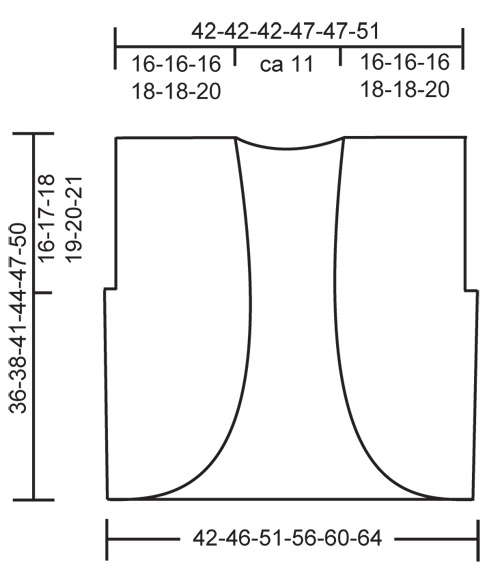 |
|
Have you finished this pattern?Tag your pictures with #dropspattern #goldenrosesbolero or submit them to the #dropsfan gallery. Do you need help with this pattern?You'll find 7 tutorial videos, a Comments/Questions area and more by visiting the pattern on garnstudio.com. © 1982-2025 DROPS Design A/S. We reserve all rights. This document, including all its sub-sections, has copyrights. Read more about what you can do with our patterns at the bottom of each pattern on our site. |
|








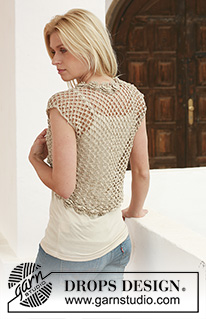


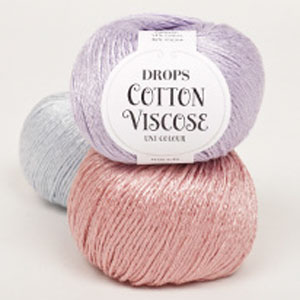


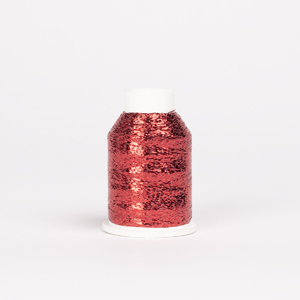





















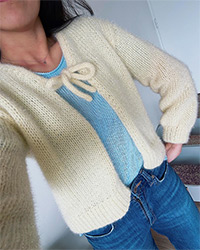
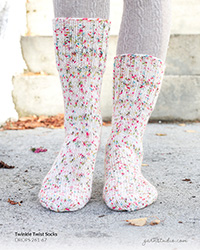
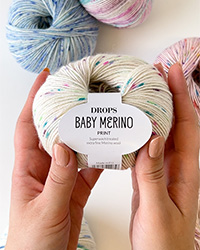
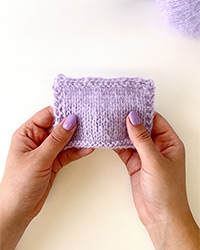
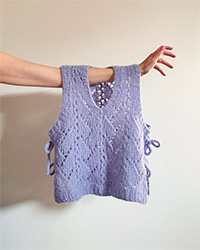

Post a comment to pattern DROPS 111-25
We would love to hear what you have to say about this pattern!
If you want to leave a question, please make sure you select the correct category in the form below, to speed up the answering process. Required fields are marked *.